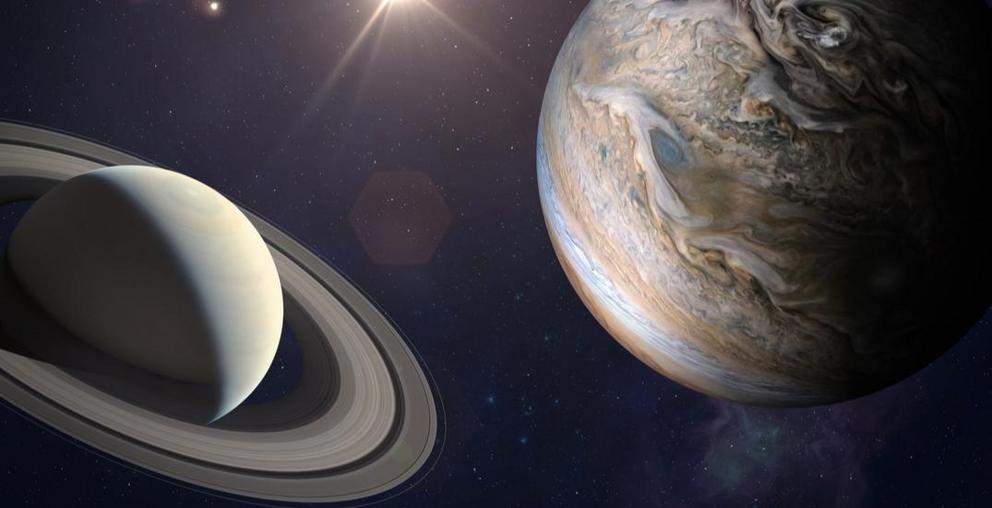Jupiter-Saturn Conjunction is moving to its high-point conclusion on 21st December
In the Evening Sky now Jupiter and Saturn are coming closer and closer together until on December 20/21/22 they will be so close as to appear as one starlight planet in the sky at the time of the Solstice. At the moment they are at about 25/30 degrees above the horizon in the western sky around 8pm (AEST). As they get closer to one another in late December they will be lower in sky in the west but still visible as one star at about 20 degrees above horizon - they will be setting then near 8pm.
Don't miss that view of Saturn/Jupiter as One. They have not been together visible like that for several hundred years. 2000 years ago they came together as the Star of Bethlehem in 7 BCE when Christ was born (don't believe the zero CE date). They won't be again together like this for a hundred years and more.
MORE ON JUPITER/SATURN Conjunct ~ "Alignments between these two planets are rather rare, occurring once every 20 years or so, but this conjunction is exceptionally rare because of how close the planets will appear to be to one another," said Patrick Hartigan, astronomer at Rice University. "You'd have to go all the way back to just before dawn on March 4, 1226, to see a closer alignment between these objects visible in the night sky.
Jupiter and Saturn's orbital resonance is such that they align in a "great conjunction" every 19 & 1/2 years, but they're rarely as close - from our point of view on Earth - as on December 21, 2020 when the two planets will be separated by less than a little finger's width held up to the sky.
ABC: Skywatchers are in for a rare treat as Jupiter and Saturn come so close to each other they will almost look like a single shining planet in the sky. Saturn has been trailing Jupiter across the night sky over the past few months. The two planets will draw closer and closer in the next three weeks, until they appear together above the western horizon around an hour after sunset on December 21.
This event, known as a grand conjunction, happens about once every 20 years. But the closeness of the two planets makes this a very rare conjunction. With only about a 10th of a degree separating the two planets - that's a fifth of the width of the Moon - this is the closest they will have appeared in the sky to each other in nearly 400 years. The last time it occurred was in 1623. They will be so close together that you will be able to see them in one eyepiece of a telescope, says Andrew Jacob, curator at Sydney Observatory.
When is best time to see the two planets?
From now onwards, Jupiter and Saturn will get noticeably closer night by night above the western horizon in the evening twilight. "This is a good chance to see the motions [of the sky] in action," Dr Jacob says.
On December 17, the planets - now just a finger-width apart - will put on a pretty show with the crescent Moon, says amateur astronomer Ian Musgrave. "That will look particularly spectacular both to the unaided eye as well as binoculars and telescopes," Dr Musgrave says.
Cool fact: If you hold your left fist out at arm's length and cover the Moon with the knuckle of your index finger, not only will you hide Jupiter and Saturn you'll block out nearly 80 per cent of all the known moons in our solar system, (as well as Pluto, which will be under your little finger but too small to see).
By December 21, Jupiter and Saturn will appear in the evening twilight about half an hour after sunset, but they will only be visible for an hour before disappearing below the western horizon. "The further north you are the longer they are in the sky," Dr Musgrave says.
Geminids Meteor shower in mid-December. December is also the month to see the annual Geminids meteor shower. And this year, with no moon to wash out the view, it is set to be a beauty. . The meteor shower, which is caused by Earth passing through a trail of debris created by the asteroid 3200 Phaethon, will be at its best on the early morning of December 14.
"We should see rates between one every minute to every two minutes over most of Australia, which is pretty damn good," Dr Musgrave says. The meteors come from a point in the constellation of Gemini, which rises in the late evening and is at its highest - and will give the best view - around 2:00am. "If you're looking north it's very easy to see Castor and Pollux [the two bright stars of Gemini]. "The radiant of the Geminids is just below Castor, and off to one side you've got Orion and Taurus." There will be less meteors on December 13, but if you stay up, you'll be rewarded with the crescent Moon and Venus near each other on the eastern horizon around half an hour before sunrise. You will also catch decent rates on the early morning of December 15.

